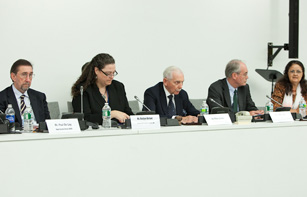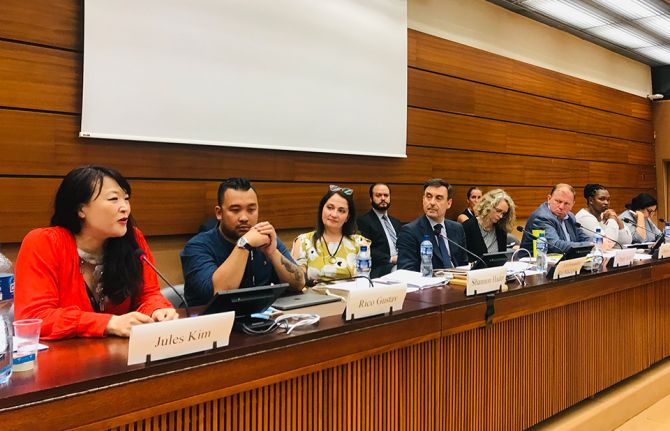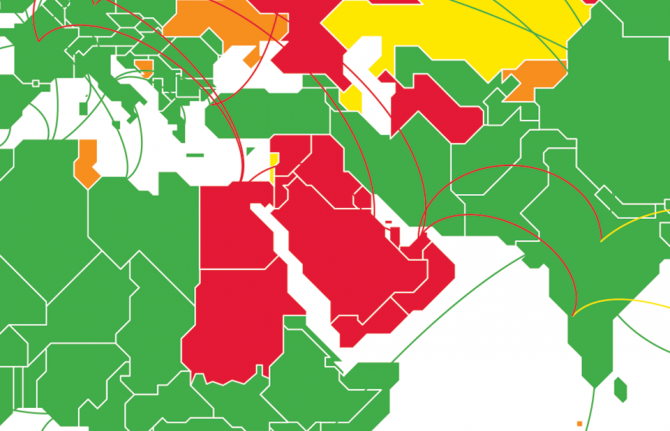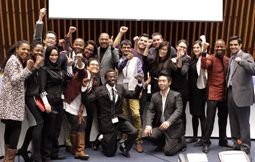
Feature Story
Partners come together to lessen HIV-risk for migrants and mobile populations
10 June 2011
10 June 2011 10 June 2011
(Left to Right): Paul De Lay, UNAIDS Deputy Executive Director; Ms. Rosilyne Borland, HIV and Health Promotion Coordinator, IOM; Ambassador William Lacy Swing, Deputy General, IOM; Mr. Udo Janz, Director of UNHCR New York; Dr. Sophia Kisting, Director, ILO/AIDS; at Migration and HIV event, held at UN Headquarters, NYC, on June 10, 2011.
Credit: UNAIDS/B. Hamilton
For the world’s 214 million international migrants and 740 million internal migrants the sometimes challenging conditions of the migration process can leave them vulnerable to HIV infection. Yet, even with the increasing interest in the health and human rights of this key group, the links between migration, population mobility and HIV are still not widely understood.
During the General Assembly High Level Meeting on AIDS in New York governments, civil society partners and intergovernmental agencies came together to explore the relationship between migration and the AIDS epidemic and to examine ways of increasing access to HIV services for people on the move.
The side-event, on 10 June, was sponsored by the International Organization for Migration (IOM), the International Labour Organization (ILO), the UN High Commissioner for Refugees (UNHCR) and UNAIDS.
Ambassador William Lacy Swing, IOM’s Director General and Dr Paul De Lay, UNAIDS Deputy Executive Director, Programme, co-hosted the event. This follows the signing of a revised cooperation of agreement between the two organizations in January this year. The agreement addresses the potential vulnerability of migrants to HIV and strengthens efforts to integrate migrants and mobile populations into AIDS policies and programmes at national, regional and international levels.
“We must harness the benefits of migration for migrants and states, by ensuring migrants can access HIV prevention, care, treatment and support services,” said Ambassador Swing.
We must harness the benefits of migration for migrants and states, by ensuring migrants can access HIV prevention, care, treatment and support services
William Lacy Swing, Director General, IOM
Dr De Lay raised an issue which many ‘people on the move’ face on a daily basis: discrimination. He spoke of the need to vigorously challenge discrimination directed at migrants, and would-be migrants, which prevents freedom of movement. These include the HIV-related entry, stay and residency restrictions in some countries. “Every individual should have equal access to freedom of movement regardless of HIV status. UNAIDS opposes restrictions that single out HIV for special treatment and that restrict movement based on HIV status only. Such restrictions are discriminatory,” he said.
Best practices
The side-event emphasized the importance of sharing best practices and lessons learned by governments and civil society on managing migration and HIV and ensuring the rights of migrants to access health and social services.
It was acknowledged that while mobility in and of itself does not necessarily result in increased health risks, the sometimes challenging conditions of the migration process—before migration, during movement, in destination communities and upon return—may impact the health of migrants and make them more vulnerable to the virus.
International commitments
The meeting explored progress on a number of international commitments and policy frameworks such as sections of the 2001 UNGASS Declaration of Commitment on AIDS which facilitate access to HIV programmes for migrants and mobile workers.
Migration-related aspects of the ILO Recommendation on HIV and AIDS and the World of Work, 2010 (No 200) were also discussed. Dr Sophia Kisting, Director of ILO/AIDS, stressed that stigma and discrimination, difficult working conditions and long separation from their families and cultures increase migrant workers’ vulnerability to HIV. “For these reasons, the Recommendation makes special mention of migrant workers. It calls on countries of origin, transit and destination to take measures to ensure access to HIV prevention, treatment, care and support services for such workers,” she said.
Every individual should have equal access to freedom of movement regardless of HIV status
Dr Paul de Lay, UNAIDS Deputy Executive Director, Programme
In its Technical cooperation projects, the ILO has promoted an integrated approach involving a variety of actors, such as government, recruitment agencies and trades unions. Programmes in Indonesia, Nepal and Sri Lanka have shown the usefulness of this approach and succeeded in including HIV in pre-departure training for labour migrants and initiating policy dialogue between sending and receiving countries.
Addressing such issues is of key importance given that, for example, according to Sri Lanka’s national AIDS committee, some 30-40% of women in Sri Lanka who test positive for HIV have returned home after living in the Middle East.
Udo Janz, Director of UNHCR New York Office, welcomed the chance afforded by the side-meeting to consolidate gains made and chart future action in ensuring migrants and mobile populations, including those forcibly displaced, are provided with HIV services.
UN General Assembly High Level Meeting on AIDS
Thirty years into the AIDS epidemic, and 10 years since the landmark UN General Assembly Special Session on HIV/AIDS, the world has come together to review progress and chart the future course of the global AIDS response at the 2011 UN General Assembly High Level Meeting on AIDS from 8–10 June 2011 in New York. Member States are expected to adopt a new Declaration that will reaffirm current commitments and commit to actions to guide and sustain the global AIDS response.



